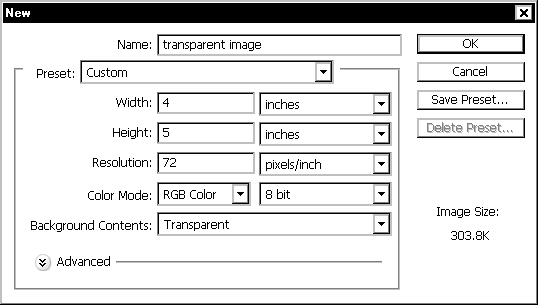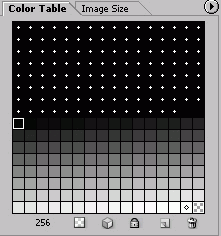How To Create Background Cs3
(Archives) Adobe Photoshop CS3: Creating Transparent Images
Terminal updated
This article is based on legacy software.
Photoshop offers a unique layer system for creating images, and many options are available to create different backgrounds for your image. By creating a transparent background for an image, lower layers are allowed to show through without whitespace or unwanted parts of the epitome. To achieve this upshot, you lot can create a transparent background for an prototype or brand an existing paradigm'due south background transparent.
For more than information on a background, refer to Working with Colors.
Using the Transparency Pick
You can apply the Transparency option to create an prototype on a unmarried layer with no background color values.
-
From the File menu, select New...
The New dialog box appears.

-
In the Proper name text box, type the name of your image.
-
Set the width and height for the image.
-
From the Background Contents pull-down list, select Transparent.
-
Click OK.
Creating Transparency
When creating a transparent background, the colors that you select in the Color Table will become transparent; therefore, this will piece of work best if the background has been deleted or converted to a solid color.
-
Open up or create the desired paradigm.
-
Adjust the background of the paradigm as necessary.
-
From the File menu, select Relieve for Web & Devices...
The Save For Web & Devices dialog box appears. -
On the Colour Table palette, select a swatch color that yous would similar to become transparent in your image.

-
At the bottom of the Color Table palette, click Maps Selected Colors to Transparent.

-
(Optional) Echo steps 9 and x until you achieve the desired result.
-
Click Save.
The Save Optimized Equally dialog box appears. -
From the Save in pull-down list, select the desired location to save your file.
-
In the File name text box, type a name for your image.
-
Click Save.
The image is now saved with its transparencies.
Notation: If the Supercede Files dialog box appears, click Replace.
Deleting an Existing Background
You may find an epitome y'all want to use simply may not want the groundwork of that epitome. Removing the groundwork color with the Magic Wand Option works best if the image has a simple one-color background. Nonetheless, if you accept a circuitous, multicolored groundwork (e.g., the background in a photograph) y'all volition want to use the Select Inverse Option.
Deleting a Groundwork: Magic Wand Option
-
In the Layers palette, double click the background layer.
NOTE: This may be the only layer present.
The New Layer dialog box appears. -
In the Proper name text box, verify that information technology reads Layer 0.
Note: Practice not make changes to the Opacity and Way settings. -
Click OK.
-
From the Toolbox, select Magic Wand Tool .

-
In the image, click the groundwork.
NOTES:
The Magic Wand tool selects like colors in the vicinity of where you click.
An blithe dashed line appears effectually the background or area of similar colour.
HINTS:
To add together to the selected expanse, press and hold [Shift] while clicking.
To deselect areas, press and hold [Alt] while clicking. -
One time the groundwork is selected, printing [Delete].
The groundwork (or selected area) becomes transparent. - (Optional) If the epitome has a multicolored groundwork (due east.g., the groundwork of a photo), and y'all choose not to apply the Select Inverse Pick, y'all may find information technology necessary to repeat steps v-6 to delete the remaining parts of the background or to delete other parts of the photo yous desire transparent.
Deleting a Background: Select Inverse Option
If you are working with a circuitous, multicolored groundwork (e.g., the background in a photograph) you volition want to utilise the Select Inverse Option. This option allows you to select the area of the image you lot would similar to remain visible, while making the rest of the paradigm transparent.
-
In the Layers palette, double click the background layer.
Annotation: This may be the simply layer present.
The New Layer dialog box appears. -
In the Name text box, verify that it reads Layer 0.
Notation: Do not make changes to the Opacity and Mode settings. -
Click OK.
-
From the Toolbox, select an appropriate selection tool.
-
Select the surface area of the prototype y'all want to remain visible.
-
From the Select card, select Inverse.
The background of your prototype is now selected. -
Press [Delete].
The background (or the area effectually your selected image) becomes transparent.
How To Create Background Cs3,
Source: https://www.uwec.edu/kb/article/adobe-photoshop-cs3-creating-transparent-images/
Posted by: graydowits.blogspot.com


0 Response to "How To Create Background Cs3"
Post a Comment